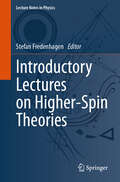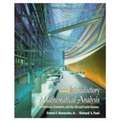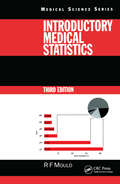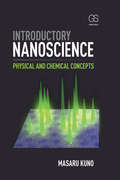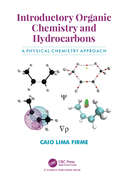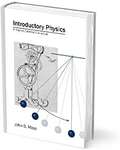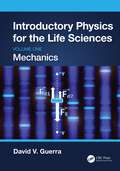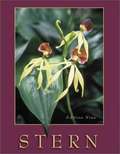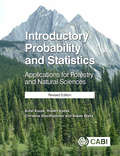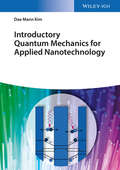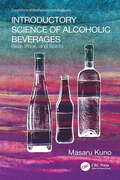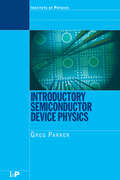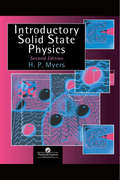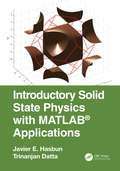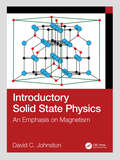- Table View
- List View
Introductory Lectures on Higher-Spin Theories (Lecture Notes in Physics #1028)
by Stefan FredenhagenThe book offers a pedagogical introduction to higher-spin gauge theories. These theories build upon fundamental gauge theories that are crucial for understanding core interactions. Electromagnetism and nuclear forces are associated with gauge fields of spin 1, while gravity can be conceptualized as a gauge theory of spin 2. This prompts the intriguing inquiry: do higher-spin gauge theories exist? Such theories would extend gravity, incorporating massless gauge fields of spins higher than two. They appear to bear connections to string theory and offer a captivating framework for exploring gravity and aspects of quantum gravity. The book initiates with a primer offering a comprehensive discussion on higher spins, delving into the challenges of establishing coherent interactions. It then explores methodologies to surmount these challenges within three-dimensional space-time. Furthermore, it investigates the emergence of asymptotic symmetry algebras, establishing links to a holographic dual conformal theory. The final chapter introduces Vasiliev’s approach to higher-spin gauge theory in four dimensions. Designed for advanced students and young researchers in theoretical physics and mathematical physics, the book aims to elucidate fundamental ideas, concepts, and tools underpinning higher-spin gauge theories. The inclusion of numerous exercises complements and illustrates the content, preparing readers for engagement with the subject's original literature and ongoing developments. To fully engage with the book's arguments, a prerequisite understanding of field theories and conventional gauge theories, including gravity, is assumed.
Introductory Mass Spectrometry
by Stephen ShraderMass spectrometry has played an integral part in the study of organic molecular structures for more than 50 years, offering significant information from small amounts of sample. The mass spectrum produced by electron impact ionization presents a pattern of peaks that can often give definitive structural information about an unknown compound. Introd
Introductory Mathematical Analysis for Business, Economics, and the Life and Social Sciences (Ninth Edition)
by Ernest F. Haeussler Richard S. PaulThis ninth edition of Introductory Mathematical Analysis continues to provide a mathematical foundation for students in business, economics, and the life and social sciences. It begins with noncalculus topics such as equations, functions, matrix algebra, linear programming, mathematics of finance, and probability. Then it progresses through both single-variable and multivariable calculus, including continuous random variables.
Introductory Medical Statistics, 3rd edition
by Richard F. MouldIntroductory Medical Statistics, now in its third edition, is an introductory textbook on basic statistical techniques. It is written for physicians, surgeons, radiation oncologists, medical physicists, radiographers, hospital administrators, medical statisticians in training, biochemists, and other professionals allied to medicine. It is suitable
Introductory Nanoelectronics: Physical Theory and Device Analysis
by Vinod Kumar KhannaThis introductory text develops the reader’s fundamental understanding of core principles and experimental aspects underlying the operation of nanoelectronic devices. The author makes a thorough and systematic presentation of electron transport in quantum-confined systems such as quantum dots, quantum wires, and quantum wells together with Landauer-Büttiker formalism and non-equilibrium Green’s function approach. The coverage encompasses nanofabrication techniques and characterization tools followed by a comprehensive exposition of nanoelectronic devices including resonant tunneling diodes, nanoscale MOSFETs, carbon nanotube FETs, high-electron-mobility transistors, single-electron transistors, and heterostructure optoelectronic devices. The writing throughout is simple and straightforward, with clearly drawn illustrations and extensive self-study exercises for each chapter. Introduces the basic concepts underlying the operation of nanoelectronic devices. Offers a broad overview of the field, including state-of-the-art developments. Covers the relevant quantum and solid-state physics and nanoelectronic device principles. Written in lucid language with accessible mathematical treatment. Includes extensive end-of-chapter exercises and many insightful diagrams.
Introductory Nanoscience: Physical and Chemical Concepts
by Masaru KunoDesigned for students at the senior undergraduate and first-year graduate level, Introductory Nanoscience takes a quantitative approach to describing the physical and chemical principles behind what makes nanostructures so fascinating. This textbook provides a foundation for understanding how properties of materials change when scaled to nano-size, explaining how we may predict behavior and functionality.
Introductory Oceanography
by Harold V. Thurman Alan P. TrujilloThis book is intended to help students in their quest to find out more about oceans. Because of its comprehensive scope and excellent resource materials, it can also serve as an excellent reference work for those involved in oceanography.
Introductory Organic Chemistry and Hydrocarbons: A Physical Chemistry Approach
by Caio Lima FirmeA novel proposal for teaching organic chemistry based on a broader and simplified use of quantum chemistry theories and notions of some statistical thermodynamic concepts aiming to enrich the learning process of the organic molecular properties and organic reactions. A detailed physical chemistry approach to teach organic chemistry for undergraduate students is the main aim of this book. A secondary objective is to familiarize undergraduate students with computational chemistry since most of illustrations of optimized geometries (plus some topological graphs) and information is from quantum chemistry outputs which will also enable students to obtain a deeper understanding of organic chemistry.
Introductory Physical Science
by Uri Haber-Schaim Peter Gendel H. Graden KirkseyNIMAC-sourced textbook
Introductory Physics
by John MaysAppropriate for grade-level 11th to nth grade students. Introductory Physics incorporates math, history, and epistemology alongside the beautiful graphics and lucid text in a modestly-sized volume that students will appreciate. This book was designed for grade-level freshmen, but it is also suitable for physics in the sophomore or junior year. In fact, optional chapters are added for the benefit of schools where physics occurs in 10th or 11th grade and students can move more quickly through the material. Mathematical problems are rigorous and challenging, but only assume that students are taking Algebra I concurrently.
Introductory Physics for Biological Scientists
by Christof M. AegerterWhy do elephants have sturdier thigh bones than humans? Why can't ostriches fly? How do bacteria swim through fluids? With each chapter structured around relevant biological case studies and examples, this engaging, full-colour book introduces fundamental physical concepts essential in the study of biological phenomena. Optics is introduced within the context of butterfly wing colouration, electricity is explained through the propagation of nerve signals, and accelerated motion is conveniently illustrated using the example of the jumping armadillo. Other key physical concepts covered include waves, mechanical forces, thermodynamics and magnetism, and important biological techniques are also discussed within this context, such as gel electrophoresis and fluorescence microscopy. A detailed appendix provides further discussion of the mathematical concepts utilised within the book, and numerous exercises and quizzes allow readers to test their understanding of key concepts. This book is invaluable to students aiming to improve their quantitative and analytical skills and understand the deeper nature of biological phenomena.
Introductory Physics for the Life Sciences (Undergraduate Texts in Physics)
by Simon Mochrie Claudia De GrandiThis classroom-tested textbook is an innovative, comprehensive, and forward-looking introductory undergraduate physics course. While it clearly explains physical principles and equips the student with a full range of quantitative tools and methods, the material is firmly grounded in biological relevance and is brought to life with plenty of biological examples throughout.It is designed to be a self-contained text for a two-semester sequence of introductory physics for biology and premedical students, covering kinematics and Newton’s laws, energy, probability, diffusion, rates of change, statistical mechanics, fluids, vibrations, waves, electromagnetism, and optics. Each chapter begins with learning goals, and concludes with a summary of core competencies, allowing for seamless incorporation into the classroom. In addition, each chapter is replete with a wide selection of creative and often surprising examples, activities, computational tasks, and exercises, many of which are inspired by current research topics, making cutting-edge biological physics accessible to the student.
Introductory Physics for the Life Sciences (Volume 2): Quantity-Based Analysis
by David V. GuerraThis textbook provides an accessible introduction to physics for undergraduate students in the life sciences, including those majoring in all branches of biology, biochemistry, and psychology and students working on pre-professional programs such as pre-medical, pre-dental, and physical therapy. The text is geared for the algebra-based physics course, often named College Physics in the United States.The order of topics studied in this volume requires students to first understand a concept, such as the conservation of energy, momentum, voltage, or current, the change in a quantity such as entropy, or the rules of ray and wave optics. Then, students apply these concepts to solve problems in the areas of thermodynamics, electrical circuit, optics, and atomic and nuclear physics.Throughout the text these quantity-based applications are used to understand systems that are critical to the understanding of biological systems, such as the entropy of evolution, the signal down the axon of a nerve cell, the optics of the eye, and the operation of a laser.This is part 2 of a two-volume set; volume 1 introduced students to the methods of mechanics and applied these problem-solving techniques to explicitly biological topics such as the sedimentation rate of red blood cells in haemoglobin, the torques and forces on a bacterium employing a flagellum to propel itself through a viscous fluid, and the terminal velocity of a protein moving in a gel electrophoresis device.Key features: Organized and centered around analysis techniques, not traditional mechanics and E&M Presents a unified approach, in a different order, meaning that the same laboratories, equipment, and demonstrations can be used when teaching the course Demonstrates to students that the analysis and concepts they are learning are critical to the understanding of biological systems
Introductory Physics for the Life Sciences: Mechanics (Volume One)
by David V. GuerraThis textbook provides an accessible introduction to physics for undergraduate students in the life sciences, including those majoring in all branches of biology, biochemistry, and psychology and students working on pre-professional programs such as pre-medical, pre-dental, and physical therapy. The text is geared for the algebra-based physics course, often named College Physics in the United States. The order of topics studied are such that most of the problems in the text can be solved with the methods of Statics or Dynamics. That is, they require a free body diagram, the application of Newton’s Laws, and any necessary kinematics. Constructing the text with a standardized problem-solving methodology, simplifies this aspect of the course and allows students to focus on the application of physics to the study of biological systems. Along the way, students apply these techniques to find the tension in a tendon, the sedimentation rate of red blood cells in haemoglobin, the torques and forces on a bacterium employing a flagellum to propel itself through a viscous fluid, and the terminal velocity of a protein moving in a Gel Electrophoresis device. This is part one of a two-volume set; volume 2 introduces students to the conserved-quantities and applies these problem-solving techniques to topics in Thermodynamics, Electrical Circuits, Optics, and Atomic and Nuclear Physics always with continued focus on biological applications. Key Features: Organised and centred around analysis techniques, not traditional Mechanics and E&M. Presents a unified approach, in a different order, meaning that the same laboratories, equipment, and demonstrations can be used when teaching the course. Demonstrates to students that the analysis and concepts they are learning are critical to the understanding of biological systems.
Introductory Physics: Summaries, Examples, and Practice Problems
by Michael AntoshPhysics describes how motion works in everyday life. Clothes washers and rolling pins are undergoing rotational motion. A flying bird uses forces. Tossing a set of keys involves equations that describe motion (kinematics). Two people bumping into each other while cooking in a kitchen involves linear momentum. This textbook covers topics related to units, kinematics, forces, energy, momentum, circular and rotational motion, Newton’s general equation for gravity, and simple harmonic motion (things that go back and forth). A math review is also included, with a focus on algebra and trigonometry. The goal of this textbook is to present a clear introduction to these topics, in small pieces, with examples that readers can relate to. Each topic comes with a short summary, a fully solved example, and practice problems. Full solutions are included for over 400 problems. This book is a very useful study guide for students in introductory physics courses, including high school and college students in an algebra-based introductory physics course and even students in an introductory calculus-level course. It can also be used as a standalone textbook in courses where derivations are not emphasized.
Introductory Plant Biology
by Kingsley R. Stern Shelley Jansky James E. BidlackThis introductory text assumes little prior scientific knowledge on the part of the student. It includes sufficient information for some shorter introductory botany courses open to both majors and nonmajors, and is arranged so that certain sections can be omitted without disrupting the overall continuity of the course. Stern emphasizes current interests ethnobotanical while presenting basic botanical principles.
Introductory Probability and Statistics: Applications for Forestry and Natural Sciences (Revised Edition)
by Robert Kozak Antal Kozak Christina Staudhammer Susan WattsAll students, practitioners and researchers in forestry and related disciplines need a good grounding in statistics and probability. This need is increasing as techniques for gathering and analysing large amounts of data are becoming commonplace. This revised edition of this unique textbook is specifically designed for statistics and probability courses taught to students of forestry and related disciplines. It introduces probability, statistical techniques, data analysis, hypothesis testing, experimental design, sampling methods, nonparametric tests and statistical quality control, using examples drawn from a forestry, wood science and conservation context. The book now includes several new practical exercises for students to practice data analysis and experimental design themselves. It has been updated throughout, and its scope has been broadened to reflect the evolving and dynamic nature of forestry, bringing in examples from conservation science, recreation and urban forestry. - Specifically written and designed to teach statistics and probability to students of forestry and related disciplines in the natural sciences - This revised edition has been broadened to reflect the dynamism of modern forestry -Chapters in this revised edition include new practical exercises allowing students to practice data analysis and experimental design
Introductory Quantum Mechanics for Applied Nanotechnology
by Dae Mann KimThis introductory textbook covers fundamental quantum mechanics from an application perspective, considering optoelectronic devices, biological sensors and molecular imagers as well as solar cells and field effect transistors. The book provides a brief review of classical and statistical mechanics and electromagnetism, and then turns to the quantum treatment of atoms, molecules, and chemical bonds. Aiming at senior undergraduate and graduate students in nanotechnology related areas like physics, materials science, and engineering, the book could be used at schools that offer interdisciplinary but focused training for future workers in the semiconductor industry and for the increasing number of related nanotechnology firms, and even practicing people could use it when they need to learn related concepts.The author is Professor Dae Mann Kim from the Korea Institute for Advanced Study who has been teaching Quantum Mechanics to engineering, material science and physics students for over 25 years in USA and Asia.
Introductory Quantum Optics
by Christopher Gerry Peter KnightThis book provides an elementary introduction to the subject of quantum optics, the study of the quantum mechanical nature of light and its interaction with matter. The presentation is almost entirely concerned with the quantized electromagnetic field. Topics covered include single-mode field quantization in a cavity, quantization of multimode fields, quantum phase, coherent states, quasi-probability distribution in phase space, atom-field interactions, the Jaynes-Cummings model, quantum coherence theory, beam splitters and interferometers, dissipative interactions, nonclassical field states with squeezing etc. , 'Schrödinger cat' states, tests of local realism with entangled photons from down-conversion, experimental realizations of cavity quantum electrodynamics, trapped ions, decoherence, and some applications to quantum information processing, particularly quantum cryptography. The book contains many homework problems and an extensive bibliography. This text is designed for upper-level undergraduates taking courses in quantum optics who have already taken a course in quantum mechanics, and for first and second year graduate students.
Introductory Readings in the Philosophy of Science
by E. D. Klemke Robert Hollinger David W. Rudge A. David KlineFor nearly two decades, "Introductory Readings in the Philosophy of Science" has distinguished itself as the standard for texts specifically designed to meet the needs of beginning students. Retaining the best essays from the first two editions, the editors have added ten important new selections to maintain this influential text's relevance for today and tomorrow. Readings cover such timely and important topics as feminism and the sciences, the effects of science on society, the natural versus the social sciences, and science and human values.
Introductory Science of Alcoholic Beverages: Beer, Wine, and Spirits (Foundations of Biochemistry and Biophysics)
by Masaru KunoIntroductory Science of Alcoholic Beverages provides readers an engaging introduction to the science behind beer, wine, and spirits. It illustrates not only the chemical principles that underlie what alcoholic beverages are, why they are the way they are and what they contain, but also frames them within the context of historical and societal developments. Discussed chapter topics include introductions to beer, wine, and spirits; the principles behind fermentation and distillation; and overviews of how each beverage class is made. The chapters highlight the unique chemistries that lend beer, wine, and spirits their individuality, as well as the key chemicals that impart their characteristic aroma and flavor profiles. This book goes beyond focused descriptions of individual alcoholic beverages by summarizing their common chemical lineage and illuminating the universal scientific principles that underpin them. It will be of interest to students of physics and chemistry, as well as enthusiasts and connoisseurs of beer, wine, and spirits.
Introductory Semiconductor Device Physics
by Greg ParkerIntroduction to Semiconductor Device Physics is a popular and established text that offers a thorough introduction to the underlying physics of semiconductor devices. It begins with a review of basic solid state physics, then goes on to describe the properties of semiconductors including energy bands, the concept of effective mass, carrier concentr
Introductory Solid State Physics
by H.P. MyersAssuming an elementary knowledge of quantum and statistical physics, this book provides a comprehensive guide to principal physical properties of condensed matter, as well as the underlying theory necessary for a proper understanding of their origins. The subject matter covers the principal features of condensed matter physics, but with particular accent on the properties of metal alloys. Relevance to technical applications is recognized.
Introductory Solid State Physics with MATLAB Applications
by Javier E. Hasbun Trinanjan DattaSolid state physics, the study and prediction of the fundamental physical properties of materials, forms the backbone of modern materials science and has many technological applications. The unique feature of this text is the MATLAB®-based computational approach with several numerical techniques and simulation methods included. This is highly effective in addressing the need for visualization and a direct hands-on approach in learning the theoretical concepts of solid state physics. The code is freely available to all textbook users. Additional Features: Uses the pedagogical tools of computational physics that have become important in enhancing physics teaching of advanced subjects such as solid state physics Adds visualization and simulation to the subject in a way that enables students to participate actively in a hand-on approach Covers the basic concepts of solid state physics and provides students with a deeper understanding of the subject matter Provides unique example exercises throughout the text Obtains mathematical analytical solutions Carries out illustrations of important formulae results using programming scripts that students can run on their own and reproduce graphs and/or simulations Helps students visualize solid state processes and apply certain numerical techniques using MATLAB®, making the process of learning solid state physics much more effective Reinforces the examples discussed within the chapters through the use of end-of-chapter exercises Includes simple analytical and numerical examples to more challenging ones, as well as computational problems with the opportunity to run codes, create new ones, or modify existing ones to solve problems or reproduce certain results
Introductory Solid State Physics: An Emphasis on Magnetism
by David C. JohnstonIntroductory Solid State Physics: An Emphasis on Magnetism acts as a supplement to students tackling solid state physics at both the undergraduate and graduate level. The BCS theory of superconductivity is not included in undergraduate-level books, because the theory is derived at the graduate level. However, this book uses the equations derived by BCS to calculate the thermodynamic properties of superconductors such as the temperature dependence of the heat capacity using techniques accessible to undergraduates. Also covering topics such as wave diffraction, the essentials of thermodynamics, statistical mechanics and local-moment magnetism, it is useful for those studying solid state physics at any level.Key Features: Includes the BCS theory of superconductivity Provides material that is accessible to students at all levels Approaches the subject with a particular emphasis on magnetism
